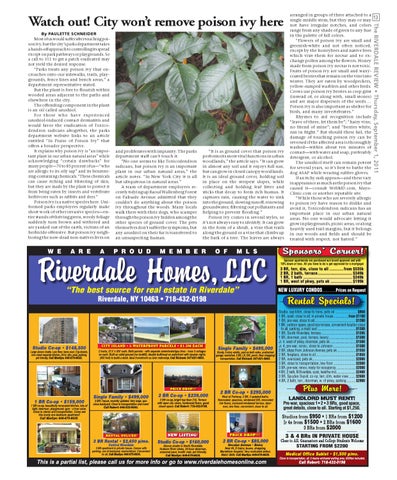By PAULETTE SCHNEIDER Most of us would suffer after touching poison ivy, but the city’s parks department takes a hands-off approach to controlling its spread except on park pathways or playgrounds. So a call to 311 to get a patch eradicated may not yield the desired response. “Parks treats any poison ivy that encroaches onto our sidewalks, trails, playgrounds, fence lines and bench areas,” a department representative stated. But the plant is free to flourish within wooded areas adjacent to the paths and elsewhere in the city. The offending component in the plant is an oil called urushiol. For those who have experienced urushiol-induced contact dermatitis and would favor the eradication of Toxicodendron radicans altogether, the parks department website links to an article entitled “In Praise of Poison Ivy” that offers a broader perspective. It explains why poison ivy is “an important plant in our urban natural areas” while acknowledging “certain drawbacks” for many people—70 to 85 percent of us—“who are allergic to its oily sap” and its benzenering-containing chemicals. “These chemicals can cause itching and blistering of skin, but they are made by the plant to protect it from being eaten by insects and vertebrate herbivores such as rabbits and deer.” Poison ivy is a native species here. Uniformed parks employees regularly make short work of other invasive species—entire stands of thriving green, weedy foliage suddenly turn brown and withered and are yanked out of the earth, victims of an herbicide offensive. But poison ivy neighboring the now-dead non-natives lives on
and proliferates with impunity. The parks department staff can’t touch it. “No one seems to like Toxicodendron radicans, but poison ivy is an important plant in our urban natural areas,” the article notes. “In New York City it is all but ubiquitous in natural areas.” A team of department employees recently tidying up Raoul Wallenberg Forest on Palisade Avenue admitted that they couldn’t do anything about the poison ivy throughout the woods. Many locals walk there with their dogs, who scamper through the poison ivy hidden among the other species of ground cover. The pets themselves don’t suffer the symptoms, but any urushiol on their fur is transferred to an unsuspecting human.
“It is as ground cover that poison ivy performs its most vital functions in urban woodlands,” the article says. “It can grow in almost any soil and it enjoys full sun, but can grow in closed canopy woodlands. It is an ideal ground cover, holding soil in place on the steepest slopes, while collecting and holding leaf litter and sticks that decay to form rich humus. It captures rain, causing the water to sink into the ground, slowing runoff, renewing groundwater, filtering out pollutants and helping to prevent flooding.” Poison ivy comes in several styles, so it’s not always easy to identify. It can grow in the form of a shrub, a vine that trails along the ground or a vine that climbs up the bark of a tree. The leaves are always
13 The RIVERDALE REVIEW • Thursday, September 1, 2011
Watch out! City won’t remove poison ivy here
arranged in groups of three attached to a single middle stem, but they may or may not have irregular notches, and colors range from any shade of green to any hue in the palette of fall colors. “Flowers of poison ivy are small and greenish-white and not often noticed, except by the honeybees and native bees which visit them for nectar and to exchange pollen among the flowers. Honey made from poison ivy nectar is not toxic. Fruits of poison ivy are small and waxycoated berries that remain on the vine into winter. They are eaten by woodpeckers, yellow-rumped warblers and other birds. Crows use poison ivy berries as crop grist (instead of, or along with, small stones) and are major dispersers of the seeds…. Poison ivy is also important as shelter for birds, and many invertebrates.” Rhymes to aid recognition include “leave of three, let them be”; “hairy vine, no friend of mine”; and “berries white, run in fright.” But should these fail, the damage of touching poison ivy can be reversed if the affected area is thoroughly washed—within about ten minutes of contact—with water and soap, preferably detergent, or alcohol. The urushiol itself can remain potent for several years, so it’s best to bathe the dog ASAP while wearing rubber gloves. If an itchy rash appears—and these vary in appearance as much as the poison ivy that caused it—consult WebMD.com, MayoClinic.com or another reputable site. “While those who are severely allergic to poison ivy have reason to dislike and avoid it, Toxicodendron radicans has an important place in our urban natural areas. No one would advocate letting it grow in playgrounds, picnic areas, or along heavily used trail margins, but it belongs in our woods and fields and should be treated with respect, not hatred.”
